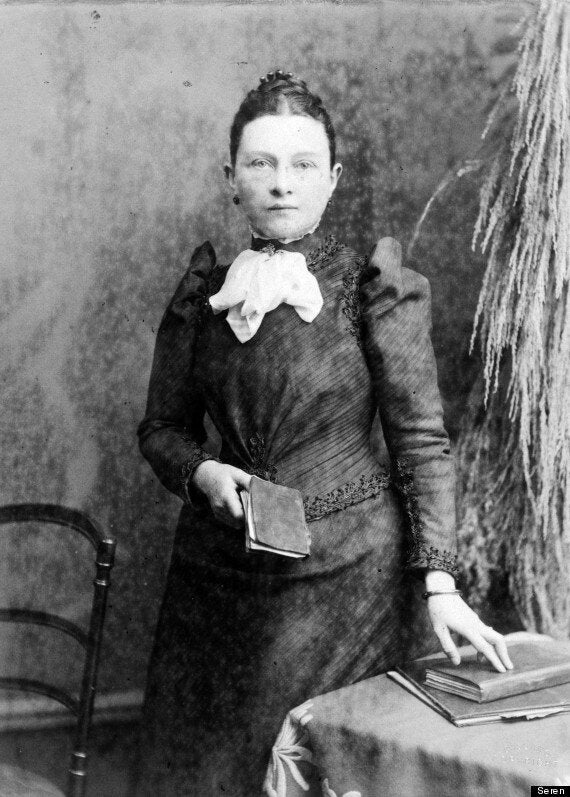They’re among the most famous unsolved murders in history, and the mystery continues to deepen.
Suspects for the shadowy figure who came to be known as Jack The Ripper have ranged from an itinerant Polish labourer to the eminent Victorian doctor Sir William Gull, and even the painter Walter Sickert.
But another theory has emerged – that is the chilling suspicion the person who carried out the 1888 murders was actually a woman.
Author John Morris puts forward his suspicions in the book Jack The Ripper: The Hand Of A Woman.
As a result of extensive research by Morris (and his late father, who was equally fascinated by the riddle) he believes the only satisfactory conclusion is that Jack was, in reality, a woman.
Scroll down for a gallery of evidence and sketches made from scenes of the murders

Lizzie Williams is put forward as a suspect in John Morris's book Jack The Ripper: The Hand Of A Woman
In a well-argued case, Morris names the key suspect as Lizzie Williams, wife of Royal gynaecologist Sir John Williams - later considered a suspect himself. Trapped in an unhappy and childless marriage, Lizzie’s only route of escape was cut off when her family fortune was lost.
Dependent on her husband for wealth, reputation and security, Morris argues that Lizzie would have done anything to defend her marriage.
The story of Morris’s research includes many twists and turns as he examines the principle players, the killer’s motivation, and modern day cases that bear some similarity to the Ripper murders.
The Ripper victims were all prostitutes, murdered and mutilated in the foggy alleyways of Whitechapel. By the surgical nature of the wounds, the killer was assumed to have some surgical knowledge.
Morris's theory is supported by the findings of an Australian scientist who in 2006 used swabs from letters supposedly sent to police by the Ripper to build a partial DNA profile of the killer.
The results suggested that the person who murdered and mutilated at least five women from 1888 onwards may have been a woman.

A composite of three Scotland Yard issued photographs of serial killer Jack The Ripper's female victims, all killed between August and September 1888 L-R: Annie Chapman, Mary Ann Nicholls and Elizabeth Stride
Ian Findlay, a professor of molecular and forensic diagnostics, told the Australian Broadcasting Corporation that he had developed a profiling technique that could extract DNA from a single cell or strand of hair up to 160 years old. Conventional DNA sampling methods require at least 200 cells.
Dr Findlay, who is based in Brisbane, travelled to London, where the evidence from the still-unsolved murders is stored at the National Archive.
The material, which was kept by Scotland Yard until 1961, includes letters sent to police at the time, some of them signed "Jack the Ripper". Most are believed to be fakes, but a handful are thought to have been written by the killer.
Dr Findlay took swabs from the back of stamps and from the gum used to seal envelopes, and possible bloodstains. He took his haul back to Brisbane, where - concentrating on swabs from the so-called "Openshaw letter", the one believed most likely to be genuine - he extracted the DNA and then amplified the information to create a profile.
The results were "inconclusive" and not forensically reliable, but he did construct a partial profile and based on this analysis, he said, "it's possible the Ripper could be female".

Author John Morris explores the theory the murderer was female
Last year a retired British murder squad detective put together what he claims is an image of Jack The Ripper.
Trevor Marriott created an e-fit of the man he believes was the responsible for the Ripper murders, a German merchant named Carl Feigenbaum, for a BBC television program.
Feigenbaum was a suspect at the time of the murders, and reportedly told his lawyer that he had a "desire to kill and mutilate every woman who falls in my way." He was later convicted of killing his landlady in Manhattan, and died in the electric chair in New York's Sing Sing prison.
No photographs of Feigenbaum exist, so the e-fit (an electronic artist's impression) was based on eyewitness descriptions.
There are hundreds of suspects who have been investigated by sleuths through the years, but no-one has ever been able to conclusively prove the killer's identity.
This is not the first time that experts have attempted to use modern policing techniques to identify the Ripper. In 2006, Scotland Yard experts created this e-fit of what they thought the Ripper would look like.
Jack The Ripper: The Hand Of A Woman, by John Morris, £9.99, Seren
WARNING: The gallery below contains some graphic content